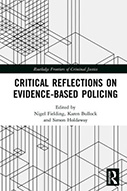Critical Reflections On Evidence-Based Policing

Editors: N. Fielding; K. Bullock, and S. Holdaway
Publishing: Abingdon, UK: Routledge, 2019. 228p.
Reviewer: Peter Neyroud | February 2021
Evidence-based policing (EBP) has become an important social and intellectual movement in policing in the two decades since Lawrence Sherman’s Police Foundation paper (1998). He described EBP as both a philosophy and an operational discipline which draws together police policy, practice and research. By 2020 there were Societies of Evidence-based Policing in the UK, USA, Canada and Australasia. The UK has, within the College of Policing, a “What Works” centre for evidence-based policing and crime reduction. The Global Police Database was able to identify more than 450 policing randomised controlled trials, and around three times that number of quasi-experiments. Drawing on this significant increase in experimental research over the last decade, the Campbell Collaboration (Crime and Justice) Coordinating Group has completed and published more than 20 systematic reviews in policing.
Despite all this, the publisher’s website description of this book starts by stating that “criminological research has been at odds with the assumptions, conventions and methodologies associated with first generation EBP. In that context EBP poses a challenge to the research community and existing evidence base and is, accordingly, hotly controversial.” In the light of that, this book is positioned by its editors, Fielding, Bullock and Holdaway, as a response to and critical assessment of the application of ‘evidence-based’ approaches to policing in the United Kingdom.
Critical reflection in this area is important, and the introduction cites David Weisburd’s and my analysis of the challenges of implementing a science-based approach in support of their critique. In our 2011 paper for the Harvard Session on Policing and Public Safety, we argued that the police had not embraced science, and that they needed to take ownership of its agenda and production. As such we were critical of the progress of evidence-based approaches in policing — critical reflection is an important part of the debate about the future of policing and police science.
Beneath that important endeavour in this book, it is, however, quickly apparent that there is a narrower and less creditable ad hominem critique of Sherman’s work on EBP. It is unusual to find an introduction apologising to the reader for a “sharpness” that is a “little pointed.” The reasons for this apology become all too apparent in Holdaway’s opening chapter. The tone and tenor of that chapter significantly detract from the value of any argument that it advances. The chapter would have been better left on the editors’ cutting room floor because it sits uneasily with what it is otherwise a very interesting collection — one which does much to provide the critical reflections promised by the title.
The first section covers systematic reviews and experimental evaluation methods. Bullock provides an overview of the process of systematic reviews and a critical reflection on one particular review from the Campbell Collaboration: Bennett’s systematic review of Neighbourhood Watch (2008). Whilst Bullock’s commentary finds many flaws in that early Campbell Review, her argument and conclusions do not reflect the more recent development of methods in systematic reviewing. The Campbell Collaboration’s guidance and practice now require careful attention to be paid to the logic model and qualitative evidence as well as the meta-analysis of the screened-in eligible studies. Campbell have also been finalising the development of qualitative review guidelines.
The two chapters on experimental methods reflect on the limitations of the “medical model” of evidence-based policing and, more specifically, in Sidebottom and Tilley’s chapter, on the use of randomised controlled trials (RCTs). The chapter makes the case for using a broader set of evaluation approaches, whilst grudgingly admitting that there is a role for RCTs. What Sidebottom and Tilley do particularly well is to provide a critical reflection on Rosenfeld, et al.’s (2014) hotspots RCT. For any student of evaluation methods, this analysis, read in conjunction with some of the classic experimental texts, is very insightful — even more so had we been offered Rosenfeld, et al.’s response.
The middle section of the book is devoted to the relationship between evidence-based policing and police practice. Brown gives us a very thoughtful review of the different approaches to police research alongside an assessment of the impact that research has had on police practice. Her description of EBP as a “rendezvous” site where different disciplines meet actually coincides rather well with Sherman’s original conception of EBP as being based on the “best evidence.” Her chapter was one of the few in the book that did not fall into the trap of caricature in portraying EBP as being solely concerned with RCTs.
The last two chapters in the middle section concern the relationship between EBP and governance and EBP and “wicked issues”. The chapter by Innes explores the role of EBP in the police response to complex problems such as Child Sexual Abuse. In discussing this, the author manages to frame well one of the key roles for EBP, namely careful descriptive analysis of the available operational data in order to understand a problem before shaping, implementing and testing potential interventions. Using evidence in this way to improve policing policy development and responses to serious harms such as Child Sexual Abuse is surely one of the “public good” gains discussed by Morrell and Rowe?
The last section of the book is entitled “steps towards applying research evidence.” It is an odd omission that this section does not focus on the role of implementation science in policing. As far back as 1986, one of the seminal early UK studies of evidence-based approaches to policing, Mollie Weatheritt’s review of “Innovations in Policing,” found that well-intentioned police strategies had largely failed because of a shallow focus on implementation. Nearly thirty years later, Maguire, et al. (2015) examined the implementation of Problem Oriented Policing and found similar flaws. In any critical reflection on EBP, a focus on implementation would seem to be central. Crawford’s chapter on police-academic partnerships is an excellent insight into the strengths and weaknesses of such partnerships. However, neither that chapter nor Fleming’s on culture really deals with the key issue of the translation of EBP into practice, nor the constant failure of the police to implement it effectively.
Overall, there are some insightful and thoughtful chapters here, but the book as a whole would have met its brief better if it had not been so obsessed with focusing on a narrow section of Sherman’s work. The editors might have done better to have critically reflected themselves that EBP is a much larger and more diverse movement than some of the chapter’s managed to describe. That wider focus and a little more grace in accepting some of gains of science and evidence in transforming policing would have provided a more significant contribution.
References:
Maguire, E.R, Uchida, C. and Hassell, K.D. (2015) Problem-Oriented Policing in Colorado Springs: a content analysis of 753 cases. Crime and Delinquency, 61(1), 71-95
Weatheritt, M. (1986) Innovations in Policing. London: Police Foundation.
Weisburd, D.W. and Neyroud, P.W. (2011) Police Science towards a new paradigm. Downloaded on 14/11/2020 from https://www.ncjrs.gov/pdffiles1/nij/228922.pdf.
Dr Peter Neyroud, Institute of Criminology, University of Cambridge, Co-Chair of the Campbell Collaboration Crime and Justice Coordinating Group.


